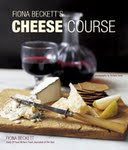
It’s hard to be objective about events in which you’re involved but I thought our Christmas Cheese School was just lovely. About 20 of us sat round a long candlelit (and electric heater-lit, hence the red glow) table in the nave of St Thomas the Martyr a late 18th century church in the centre of Bristol. (I confess I didn’t know what this part of a church was called but found the answer within seconds when I Googled it. The wonder of WikiAnswers.)
We kicked off with a talk on winter cheese by cheesemaker Todd Trethowan who explained how his Gorwydd Caerphilly changes at this time of year (the cows feed on silage rather than fresh grass which results in a more intense flavour) why you sometimes can’t buy goats cheeses (if the cheesemaker lets the goats kid) and why Vacherin is now at its best (you only have to taste it to see for yourself). We also found it went wonderfully well with the mulled cider donated by local producer Orchard Pig.
Cheesemonger Alex Te-Strote valiantly talked about how to put together a Christmas cheeseboard through several layers of cold while Andrew Cooper of the Bristol Beer Factory persuasively argued the case for putting beer as well as wine on the table.
Then I took a different angle on matching cheese by pairing Joe Schneider's Stichelton (the amazing unpasteurised version of Stilton) with a Douro red, Monbazillac sweet wine, the Bristol Beer Factory’s Ultimate Stout, local producer Bramley and Gage’s Sloe Gin and Avery’s Bristol Cream sherry. (The most popular pairings seemed to be the Monbazillac and sherry though I was very taken with the stout)
The evening was punctuated with bursts of festive organ music played by one of the Trethowans Dairy cheesemongers Charlie Usher (below with mulled cider) who won the title of young composer of the year a couple of years ago. Talk about versatile . . .

The next all day Cheese School is on Sunday February 6th at Bordeaux Quay. If you're in a panic for a last minute Christmas present you can buy gift vouchers here!
















































